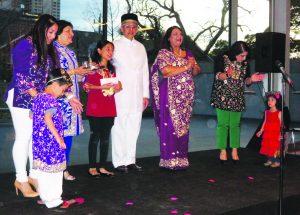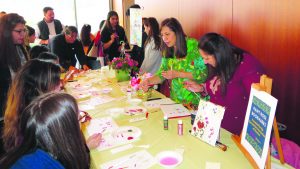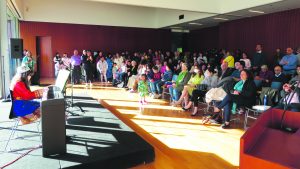Global Unity through Nowruz festivities over Four Days at Asia Society

Parsi performance
By Sanchali Basu
HOUSTON: This Spring Break, celebration of Nowruz, the Persian New Year festivities hosted by the Asia Society of Houston from March 14-17, marked the onset of spring, and brought in about 120 attendees on the weekdays and approximately 1200 attendees Friday evening. Nowruz is celebrated by more than 300 million people all over the world.
This was a free all-ages special event, open to the public, organized by the Zoroastrian Association of Houston (ZAH). It featured performances, arts and crafts, stories, and food — all inspired by Nowruz traditions! There were stalls where one could create Persian New Year greeting cards, learn to write one’s name in Farsi, Haft Seen table display, and Shahnameh display. There were fun, hands-on arts and crafts, artist doing live paintings and stalls explaining the journey along the Silk Road with artefacts from Rome, Iran, India, Indonesia and Central Asia.

Painting booth
The morning activities over 3 days included puppet stories from the Shahnameh, interactive Persian dances by students and participants, Smurgh bird collage, clay butterflies, egg decorating, creating floral bouquets, coloring activities and games.
The main hall on the second floor was abuzz with activity on the final evening and packed to capacity, while the first floor offered delicious Persian food from Reza Grill.
The grand finale event commenced with a children’s story from Shahnameh (The Epic of the Kings), followed by an introductory Persian song by Behzad Kaigobadi and group. The crowd was welcomed and greeted by Aban Rustomji of ZAH with her opening speech. Narration of an adaptation of the battle between Rustom and Sohrab from Shahnameh was done by Kaermerz Dotiwala of ZAH.

Piano recital. Photos by Yezdi Engineer and Percy Behramsha
Iranian Cultural foundation presented 2 Persian dances By Meriam, and following the Silk Road, songs of spring were sung by Ms. Tseng and students from ED White Elementary school to the accompaniment of the Ehru. A scarf/handkerchief dance from the Shan Dong province of China was performed by Elliott Kuehler and Kylie Huang of the Dance of Asian American Academy. This was followed by greetings from Ajit Giani of the Bahai Organization.
A traditional Afghani dance by the Shia Ismaili Council for Southwestern USA was very impressive and not to be left behind, the Parsis of India represented by the Rhythm India Dance company had a very interactive presentation of lively Bollywood dances. Zoroastrian migration from Iran to India between the 7th and 9th century led to the birth of the Parsis in India. They adopted the Indian custom of wearing a sari yet maintained their cultural identity. The song Natalya and Jidina taught the audience had a Garba base to it, which is a folk dance from the western state of Gujarat in India, where the Zoroastrians first landed in India, when they migrated from Iran. The interactive dance beautifully choreographed by artistic director, Arzan Gonda got the crowd moving to the rhythm of the dance and enjoying.
Houston will be looking forward to more such exceptionally well-organized events in the future.
